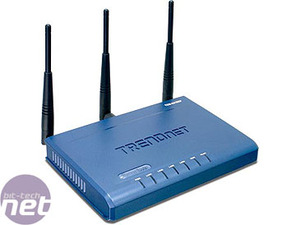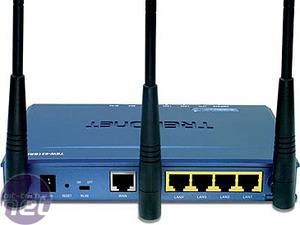TrendNet TEW-631BRP
Type: Cable/EthernetWireless: 802.11n draft
Price (as reviewed): £95 (inc VAT)
Current price: Click here
Setup
We had a couple of minor problems when we first connected the TrendNet TEW-631BRP to our cable modem. Initially, it refused to pass an internet connection to our secondary router. This Linksys EZXS55W five-port router we were employing had three Windows machines connected to it, which were connecting to the network using DHCP.Unfortunately, the TrendNet wasn’t passing the correct DNS information to this router, causing the computers on the Linksys to be unable to connect to the internet, although they could see other computers on the network. This problem seemed intermittent, and we did manage to get the secondary machines to connect to the internet. Sadly, there was no set method to do this, the computers just started to connect after we had rebooted them and the router a few times.
In addition, we couldn’t update the TrendNet to the latest firmware because it kept failing the process – even when all other cables were removed from the router and the wireless was turned off. This didn’t cause us any problems when we were testing BF2, but it may cause issues when a new game is released, though. If that happens, you’ll need to manually add the settings to the games list. We suspect that this could be just an issue with our review model, as we haven't seen this reported by anyone else. Have the patience to keep trying the updates!


Gaming performance
To assess gaming performance we played BF2 on a 64 player ranked server. In an effort to keep the testing fair we used Jolt’s Jalalabad Super Server and played at least four rounds. To stress the router and saturate our network we ran a BitTorrent application on one of our network machines. We set this to allow a maximum of 300 connections and kept it stocked up with large ISO files to download - a hefty task indeed!Out of the box, the TEW-631BRP offered the best all-round performance of the four QoS routers on test. Initially this didn’t seem to be the case, as our game of BF2 displayed a reasonable amount of lag. However, even when the game was warping, it was evident that the registration was reasonable. After about five minutes of play, the lag slowly subsided and the gameplay became as smooth as with any of the other routers. Registration was solid, and we only saw minimal fluctuations on our ping in game.
QoS
Of course, great gaming performance isn’t so great if it’s gained at the expense of other applications, such as web browsers or less well known games. Fortunately for everyone, the TEW-631BRP performed admirably in this respect. While the test machine was connected to the ranked BF2 server there was no degradation to the performance of other applications. Web pages loaded reliably, video streamed well, and we were even able to squeeze in a game of Cgoban with no hassle and no problems with latency.Wireless
With the exception of D-Link's spiffy DSL-2740b router, the TrendNet TEW-631BRP provided the fastest close range transfer by wireless of all the routers on test. It took a mere 3 minutes and 22 seconds to transfer our 750MB AVI file from within 10m of the base station.Conclusion
The TrendNet proved itself to be the strongest gaming router we had on test. Although it had the same teething problems as we found with the Zyxel, it had much better automatic priority for gaming out of the box. However, it also costs £15 more than the Zyxel P336M, but that's countered by the TrendNet's Pre-N specifications, which are considerably faster than the Zyxel's 802.11g MIMO specifications.




MSI MPG Velox 100R Chassis Review
October 14 2021 | 15:04









Want to comment? Please log in.